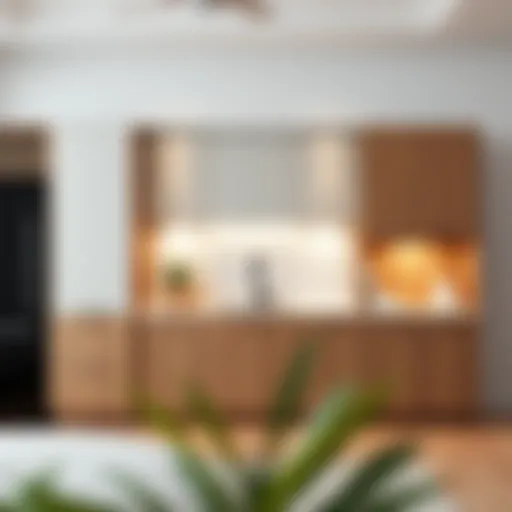Mini Hanging Pots: Versatile Decor for Any Space
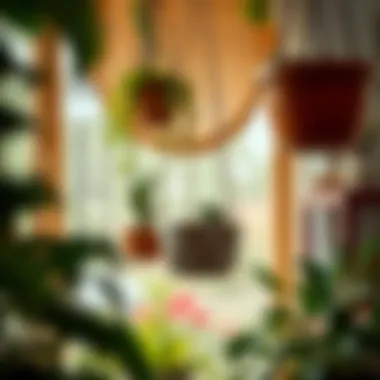

Intro
In the realm of contemporary decor, the role of plants is not simply aesthetic; rather, it speaks volumes about personal style and the desire to bring the outdoors inside. Mini hanging pots serve as a delightful amalgamation of creativity and practicality. These charming accessories not only infuse vibrancy into a space but also highlight the trend of vertical gardening, which is increasingly favored by both urban dwellers and suburban homeowners.
Hanging pots can range from small succulents that barely take up space to lush, trailing plants that cascade gracefully. They allow for an additional layer of design, transforming plain walls into living tapestries. This exploration aims to unravel the beauty and versatility of mini hanging pots, addressing their varied applications in home settings, design trends, and maintenance strategies that cater to both novices and seasoned enthusiasts alike.
"The joy of gardening doesn’t just belong to those with sprawling yards. Mini hanging pots make it possible for anyone to connect with nature, regardless of their living situation."
Let's delve into furniture styles, trends, and how mini pots can harmonize with your chosen aesthetic.
Furniture Styles and Trends
Mini hanging pots are not just about plants; they tell a story about style and personality.
Modern vs. Traditional: Understanding the Aesthetics
When it comes to integrating mini hanging pots into your decor, the choice between modern and traditional sets the stage for the overall atmosphere of your home.
- Modern Aesthetics: Sleek lines, minimalism, and a neutral palette characterize modern design. In this sphere, mini hanging pots often utilize materials like ceramics or glass, sometimes incorporating metallic accents. Plants, like air plants or neat succulents, complement this organized chaos. Their simplicity speaks volumes and feels refreshing even in tight spaces.
- Traditional Aesthetics: Here, we see a more eclectic approach, often featuring ornate designs and rustic charm. Hanging pots crafted from terra cotta or woven materials add warmth and depth. Choices like trailing ivy or flowering plants resonate well in such settings, creating a homely vibe that invites conviviality.
Color and Material Trends: What's In and What's Out
Refreshing your space with color and materials can be the difference between a drab setting and one that feels lively and engaging. Currently, earthy tones, such as terracotta and greens, are making strong comebacks, aligning with the natural aesthetic trend. The use of sustainable materials is also gaining traction, enhancing the eco-friendly narrative.
Conversely, overly bright synthetic materials might feel outdated—people are leaning towards authenticity and craftsmanship. Keeping in mind that each hanging pot should reflect not just the plant it houses but also the overall decor ethos of the space, one can start plotting a course of action.
In this article, we'll dive deeper into caring for & maintaining these stylish accessories, as well as providing practical tips and innovative ideas for enhancing your living spaces even further.
The Growing Popularity of Mini Hanging Pots
In recent years, mini hanging pots have captured the hearts of homeowners and design enthusiasts alike, transforming the way we think about indoor and outdoor spaces. These petite containers allow for a burst of greenery without occupying precious square footage. The growing appeal of these pots isn’t merely about their aesthetics; they bring with them a host of practical benefits that resonate well in today’s fast-paced living environments.
The trend towards mini hanging pots stems from a desire for more efficient use of space. Urban living often limits the size of gardens, meaning that every inch counts. Miniature plants can lend life to corners, shelves, and even bathroom spaces that might otherwise remain uninspired. Additionally, they cater to a sense of personalization that many interior décor choices lack. Homeowners today seek ways to showcase their individuality, and mini hanging pots offer just the right canvas for that expression.
Moreover, these pots have become synonymous with convenience. For those who may not have the green thumb or intricate knowledge of plants, mini hanging pots filled with easy-care plants like succulents or trailing ivy provide a low-maintenance option. This blend of style and practicality explains their uptick in popularity, as people look for ways to marry beauty with functionality.
Reasons for Their Appeal
Mini hanging pots have become an embodiment of charm and utility, resonating with various lifestyles. Their versatility is one of the most compelling reasons behind their appeal. When you hang a small plant from the ceiling or a wall, it becomes a design statement that can complement any room. Here are some primary factors contributing to their popularity:
- Space-Savvy: Perfect for small homes or apartments where floor space is at a premium. These pots free up valuable surface areas while adding visual interest.
- Aesthetic Versatility: Available in various designs and materials, they can seamlessly fit into modern, rustic, or even bohemian styles, allowing homeowners to mix and match effortlessly.
- Air Quality Improvement: Studies have shown that plants help improve indoor air quality, making mini hanging pots not just decorative, but beneficial for health too.
- Accessibility: As more people turn to gardening, the ease of care associated with the plants typically chosen for mini pots makes it an accessible hobby.
Thus, the combination of practicality and aesthetic charm has made mini hanging pots beloved additions in homes across the globe.
Historical Context
To understand the current trend of mini hanging pots, it’s essential to look back at their history. Hanging planters date back to ancient civilizations. In the Hanging Gardens of Babylon, plants floated above ground in a spectacular display of nature intertwined with engineering marvels. Fast forward to the Middle Ages, where plants were hung from ceilings in monasteries and homes to maximize the available sunlight.
The style truly gained momentum in the 1970s with the rise of macramé hangers, a trend that celebrated bohemian aesthetics and DIY crafts. The resurgence of interest in indoor gardening has brought mini hanging pots back into vogue, but with a modern twist. Today, materials vary from ceramic to recycled plastics, combining sustainability with style.
In this way, mini hanging pots have not just evolved but have come to symbolize a fusion of history, style, and a newfound appreciation for living with plants. As we journey further into this article, we will explore the intricacies of selecting the right materials, colors, and plants that can enrich the experience of using these versatile hanging pots.
Design Considerations in Choosing Mini Hanging Pots
When it comes to the art of selecting mini hanging pots, myriad aspects deserve careful thought. It's like piecing together a jigsaw puzzle where every choice influences the overall aesthetic and functionality. The goal is not just to find plants and pots that look good but to create a harmonious environment that suits personal style and plant health. Therefore, understanding design considerations is paramount for anyone—homeowners, designers, retailers, DIY enthusiasts—aiming to incorporate these elements into their living spaces.
Material Options
Materials truly shape the character and usability of mini hanging pots. The choices made here are a balance of style, functionality, and a touch of practicality.
Plastic
Plastic pots are lightweight and often the go-to choice for many. A significant aspect of plastic pots is their cost-effectiveness. Unlike heavier materials, these pots make it easy to hang and rearrange. They come in all sorts of colors and styles, matching just about any decor. However, they can be prone to fading when exposed to direct sunlight for long periods. It's a trade-off between convenience and longevity. While they last long, they may not have the timeless appeal of sturdier materials. But, hey, you can easily replace them if they don't weather well.
Ceramic
Ceramic pots exude a classic charm. Their sturdy nature gives them a touch of elegance that many interiors crave. A distinct characteristic of ceramic is its breathability; they allow moisture to escape, which keeps plants healthy. However, they can be on the heavier side, which might limit where you can hang them. Be cautious with these if your ceilings or hooks aren't up to the challenge. Plus, they tend to be pricier than their plastic counterparts. Still, for the aesthetic and the health of the plants, ceramic can be a worthwhile investment.
Metal
Metal hanging pots come with a modern, chic vibe. They often bring an industrial feel to spaces, appealing to those who prefer a less traditional look. A strong point of metal pots is their durability. Unlike plastic or ceramic, they are less likely to break. However, one must consider their thermal conductivity. Metal heats up quickly in the sun and can affect soil temperature, which could affect your plants. It's essential to choose wisely to avoid overheating delicate roots.
Biodegradable Materials
In today's eco-conscious world, biodegradable materials are stepping into the spotlight. These pots not only serve the purpose but also promote sustainable gardening practices. They decompose naturally when the time comes, meaning less waste. Their major downside is durability; they may not last as long if proper care isn't taken. Also, the variety of designs and colors might be somewhat limited compared to plastic or metal options. However, choosing biodegradable materials is a commendable way to help the environment!
Color and Style
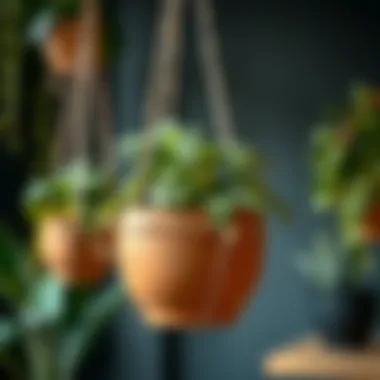

Color and style are vital pieces of the puzzle when integrating mini hanging pots into your decor. The aesthetic appearance can change the atmosphere of a room drastically.
Modern Aesthetics
Modern aesthetics lean towards sleek, clean lines and minimalistic designs. This style often includes pots in solid colors or geometric shapes. Such pots can effortlessly blend into contemporary homes, bringing a sophisticated touch without overwhelming the space. The downside? They may clash with vintage or highly decorative themes.
Rustic Themes
Ah, rustic themes evoke a sense of warmth and coziness. Here, you'll find pots made from natural materials or with earthy tones, fitting perfectly into a farmhouse-style environment. These pots can add character, underscoring a connection to nature. However, if the rest of a home leans towards modern minimalism, introducing rustic hanging pots could make the space feel cluttered or disjointed.
Minimalist Approaches
Minimalism is about stripping down to essentials. Selecting hanging pots with subtle colors and simplistic designs aligns well here. They eliminate visual noise and allow plants to shine. One potential drawback, however, is that minimalism can sometimes be perceived as stark or cold. Finding that balance is key if you're striving for an inviting environment.
Key Insight: The materials and aesthetics of your mini hanging pots set the rhythm of your interior design. A thoughtful selection will not only beautify a space but also add character and functionality.
Selecting Suitable Plants for Hanging Pots
When it comes to decorating with mini hanging pots, the right plants can make or break the aesthetic and functional appeal of the space. Selecting suitable plants is not just a matter of personal preference; it's crucial for ensuring that the plants thrive in their unique environments. Different plants have varying requirements in terms of light exposure, watering needs, and space considerations. Choosing the right species of plants can provide an array of benefits, from enhancing air quality to creating a calming atmosphere.
With the considerable range of options available, understanding the characteristics of different plant types is essential. A careful selection tailored to specific environmental conditions can lead to a more vibrant indoor space. Moreover, specific plants serve particular functions, such as providing a fresh culinary option or elevating the decor's overall design.
Best Plant Choices
Succulents
Succulents have become a darling in the realm of indoor gardening, known for their striking appearance and low maintenance requirements. Their thick, fleshy leaves allow them to store water, which makes them an excellent option for people who might often forget to water their plants. Additionally, succulents come in a variety of shapes, colors, and sizes, allowing them to fit beautifully in mini hanging pots, adding to the charm of any space.
One unique feature of succulents is their ability to thrive in bright light, making them perfect for areas by windows. However, they do require a well-draining soil mix to prevent root rot. On the downside, while they’re generally hardy, succulents can be sensitive to extreme temperatures, which can be a disadvantage if you live in a place with drastic climate changes.
Trailing Plants
Trailing plants, like pothos or string of pearls, bring a mesmerizing dynamic to any vertical space. Their natural growth pattern allows them to cascade gracefully, making them visually striking in hanging pots. One of their key characteristics is that they thrive in varied lighting conditions, although they flourish best in indirect sunlight.
The unique feature of trailing plants is their adaptability; they can be trained along various support systems or allowed to hang freely. However, they do require regular pruning to prevent them from becoming too unruly. On the flip side, they can be susceptible to pests, which necessitates monitoring and potentially timely pest management efforts.
Herbs
Herbs like basil, oregano, and thyme not only enhance the aesthetics of a space but also provide practical benefits. They can be a delightful addition to any kitchen, encouraging gardening enthusiasts to grow their own fresh ingredients. The aromatic quality of herbs can transform the atmosphere of a room, lending a relaxed, countryside vibe.
One key characteristic of herbs is their preference for bright, direct sunlight, which makes them ideal for sunny windows. The unique feature is, of course, their utility; fresh herbs significantly elevate culinary experiences. However, one must consider the space needed for their growth. Some herbs can become bushy, demanding more attention and care compared to their more ornamental counterparts.
Considerations for Plant Care
Light Requirements
Understanding light requirements is fundamental to successful plant care. Each plant has its own preference for light intensity, which can impact its growth and overall health. For mini hanging pots, finding plants that fit the lighting conditions of your home makes a significant difference in aesthetics and functionality.
Specifically, certain plants prefer direct sunlight, while others thrive in shaded areas. It's essential to assess where you plan to hang these pots, as varying levels of natural light could mean the difference between a vibrant, healthy plant and a struggling one.
The advantage is that many indoor plants are quite forgiving when it comes to light, adapting to their surroundings. However, plants placed in insufficient light may grow weak and leggy, diminishing their aesthetic appeal.
Watering Needs
Watering needs are another pivotal aspect of plant care. Different plants demand different frequencies and methods of watering, which can become tricky with hanging pots. Over-watering or under-watering can lead to health issues and even death of the plant.
Some plants prefer a dry spell between watering sessions, while others thrive in consistently moist conditions. Typically, trailing plants and herbs can require more attention to hydration than succulents. The unique feature of watering is to observe the plant's soil – checking for dampness can guide your actions.
The advantage here is that a consistent watering schedule can cultivate a healthier environment for your plants. Despite this, many may find it challenging to maintain proper watering routines, especially in busy households.
Space Considerations
Finally, space considerations play a crucial role in selecting and caring for plants in hanging pots. Understanding the space requirements of each plant allows for an attractive arrangement that doesn’t overcrowd or suffocate them.
Some trailing plants might need ample room to spread, while others might remain compact. Assessing how much space you have to offer and the growth habits of your chosen plants ensures a balanced and visually pleasing display.
The essence of space consideration is that it directly impacts the plant’s ability to grow and flourish. A well-placed hanging arrangement can create depth and intrigue in your decor. However, on the downside, improper planning could lead to cluttered aesthetics or plants competing for resources.
Innovative Display Techniques
The realm of mini hanging pots extends far beyond mere aesthetics; their display techniques play a pivotal role in maximizing both their impact and functionality. With creativity and thoughtful planning, these pots can become striking focal points in any room. Choosing the right display techniques not only enhances visual appeal but also influences how plants thrive in various environments.
There Are Numerous Display Options
Hanging Ropes and Chains
A notable technique is the use of hanging ropes and chains. These materials allow for flexible positioning at various heights, making your plant arrangement dynamic and visually interesting. One characteristic of hanging ropes is their natural texture that can provide a rustic touch or a bohemian vibe depending on the design.
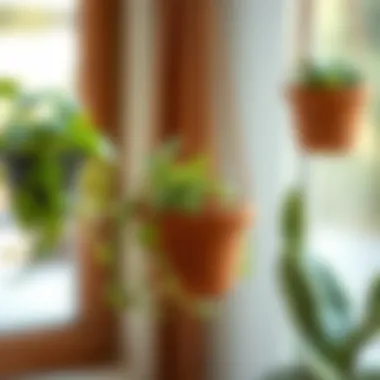

The benefit of using chains lies in their durability; they can reliably hold considerable weight, making them popular among enthusiasts with larger pots. However, one must consider that constant exposure to moisture can lead to rust in metal chains if not maintained properly. On the flip side, ropes generally blend well with various decor styles but can wear out over time more quickly compared to chains.
Wall-Mounted Fixtures
Wall-mounted fixtures provide an excellent option for smaller spaces where floor space is at a premium. These fixtures are often designed to complement the wall decor, adding another layer of style. The key characteristic here is their space-efficient design that allows homeowners to transform otherwise blank walls into vertical gardens.
The unique feature of wall-mounted fixtures is the potential for a seamless integration into the home’s aesthetic, offering a way to display plants without cluttering surfaces. One disadvantage might be the requirement for careful installation; poor mounting can lead to plant falls and potential damage. Yet, when done right, they can elevate the ambiance of a room effortlessly.
Ceiling Hooks
Ceiling hooks present yet another versatile display approach. This method allows for a floating effect, making it appear as if your plants are simply hanging in the air. Ceiling hooks are particularly valuable in rooms with taller ceilings, where other display options might not utilize the vertical space effectively.
The unique selling point of ceiling hooks is the dramatic perspective they offer. They invite admiration from below while creating an engaging overhead garden. Course, accessibility for maintenance becomes a challenge; taller plants might require more effort to care for. But, for those willing to stretch, the payoff in aesthetics is substantial.
Creating a Cohesive Look
A cohesive look is crucial for maintaining a stylish and inviting space. When incorporating mini hanging pots, it's essential to consider elements such as color coordination, complementary decor elements, and layering heights to create a harmonious atmosphere.
Color Coordination
The aspect of color coordination is vital in ensuring that the plants and pots resonate well within the chosen decor. A unified color scheme can seamlessly tie different elements of a room together. For example, if your decor features earth tones, opting for pots with similar hues amplifies a calming aesthetic.
The unique advantage of color coordination is the ability to enhance the overall space without overwhelming it. Conversely, mismatched colors can lead to a cluttered look, drawing attention away from the natural charm of the plants.
Complementary Decor Elements
Utilizing complementary decor elements involves selecting other objects in your space that harmonize with the hanging pots. This can include artwork, rugs, or furniture that shares a similar color palette or style. Essentially, it's about creating visual dialogues between your hanging plants and rest of your home.
This integration is beneficial as it builds a cohesive narrative within your decorative choices. However, one must avoid overpowering the display with too many competing elements, which can distract rather than enhance.
Layering Heights
Lastly, layering heights offers a smart way to create depth and visual interest in any display. By arranging pots at different heights, you can draw the eye across an area, making it more engaging. This method is excellent for preventing a static or boring appearance.
The beauty of layering is that it adds dimension to the arrangement. However, it’s essential to maintain balance; overly extreme differences in height may result in a disjointed look. A careful balance can result in an attractive cascade of foliage that invites closer inspection.
Practical Maintenance Tips for Mini Hanging Pots
Caring for mini hanging pots is vital for both the health of your plants and the aesthetics of your space. Without proper maintenance, these decorative elements could quickly become eyesores rather than enhancements to your living area. Here, we dive into practical tips that keep your hanging pots thriving, ensuring that they not only bring joy but also fulfill their functional roles within the decor.
Watering Techniques
Watering is perhaps the most fundamental aspect of maintaining mini hanging pots. However, it isn’t a one-size-fits-all solution. Let's break it down further.
Frequency
The frequency of watering can make or break the life of your plants. For most hanging pots, a common recommendation is to water once a week, but this can vary greatly depending on the type of plant and environmental factors.
- Key Characteristic: This recommendation serves to prevent both under-watering and over-watering—two issues that can lead to plant stress and even death.
- Why It’s Beneficial: Adhering to a set routine ensures environmental consistency for the plants, instilling a level of predictability in their growth phase.
- Unique Feature: Some plants, like succulents, benefit from much less frequent watering. Conversely, herbs might thrive on a schedule of watering every five days, depending on temperature and humidity.
- Advantages: Establishing a habit fosters intuition about the plants' needs, while disadvantages come into play if one forgets, leading to a cycle of neglect. Hence, keen observation ensures that one does not fall prey to complacency.
Methodologies
The methodology of watering refers to the techniques employed to hydrate your plants effectively.
- Key Characteristic: Different methodologies suit different plant types; for instance, a gentle pour or submerging pots in water can yield varying results.
- Why It’s Beneficial: Carefully controlling how much water the plants receive fosters healthier root systems and minimizes risks of rot.
- Unique Feature: Some DIY enthusiasts suggest using self-watering pots or employing drip irrigation systems, which can simplify the process and allow for long-term plant health.
- Advantages / Disadvantages: A thorough soaking ensures the roots are well hydrated but demands close monitoring since saturating the soil can lead to other issues.
Pest Management
Another critical aspect of maintenance involves pest management, as miniature hanging pots can attract uninvited guests.
Natural Remedies
Natural remedies for pest control draw from various sources including household items. This low-impact approach is crucial for maintaining not just plant health but also promoting a more sustainable environment.
- Key Characteristic: Using soap solutions or neem oil spray is common, relying on their non-toxic formulations to deter pests.
- Why It’s Beneficial: They reduce the risk of harmful side effects associated with chemical solutions, thus keeping your indoor air cleaner.
- Unique Feature: The appeal lies in their accessibility; most ingredients are common household staples, making them a convenient yet effective choice.
- Advantages / Disadvantages: While natural remedies tend to be safer, they may lack the immediate punch that some chemical solutions offer, possibly requiring more frequent applications.
Chemical Solutions
When natural remedies fall short, chemical solutions present a quicker albeit less desirable alternative.
- Key Characteristic: These solutions can be effective in eradicating pests rapidly, often marketed for household use.
- Why It’s Beneficial: They are often stronger and designed to handle severe infestations, providing instant relief to stressed plants.
- Unique Feature: Users should note that chemical products often contain synthetic and harsh ingredients that may have long-term effects on both plants and indoor air quality.
- Advantages / Disadvantages: Immediate results are a significant upside, but there’s the risk posed to health and the environment, as well as potential harm to beneficial insects.
Maintaining mini hanging pots doesn’t have to feel overwhelming. Understanding the balance of watering techniques, pest management, and plant care can transform these little additions into thriving, healthy displays that enhance your space. Always remember that a keen eye and regular attention are your best allies in this green endeavor.
Sustainable Practices in the Use of Mini Hanging Pots
Sustainable practices are at the heart of contemporary gardening trends, especially when it comes to mini hanging pots. This not only involves the type of materials we choose but also the plants we cultivate. By focusing on sustainability, homeowners and designers can positively impact their environments and communities, blending aesthetics with responsibility.
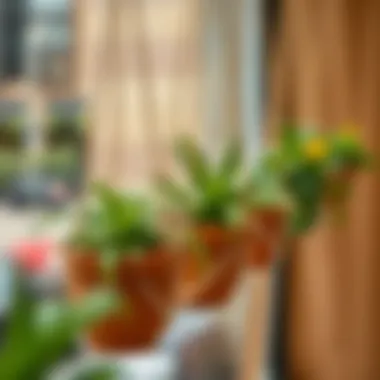

Choosing Eco-Friendly Materials
Recyclable Options
Recyclable materials have surged in popularity due to their minimal environmental impact. From various plastics to metals, these options can be remolded or repurposed, reducing waste in landfills. One of the most beneficial traits of recyclable materials is their durability, meaning less frequent replacements are needed. For instance, using recycled plastics in mini pots can bolster sustainability efforts without sacrificing visual appeal. However, not all recyclable materials are created equal; some can contain harmful additives which could leach into the soil. Homeowners should look for products marked clearly as non-toxic and safe for plant interaction.
"Choosing recyclable materials is like investing in a greener future; it pays off in the long run, not just for us but for the planet."
Locally Sourced Materials
Selecting locally sourced materials is not just a trend but a commitment to support local economies and reduce transportation-related carbon footprints. Using clay from local potters or wooden planters crafted from regional timber offers a charming and unique aesthetic while promoting sustainability. This practice strengthens community ties and can often result in a more authentic decorative piece. Yet, availability is sometimes a limitation; depending on the area, the choices may not be as diverse compared to mass-produced alternatives.
Enhancing Biodiversity
Native Plant Species
Incorporating native plant species into mini hanging pots nurtures local ecosystems and enhances biodiversity. These plants are adapted to their local environments, requiring less water and maintenance while providing habitat for local wildlife. They boast resilience against pests and diseases that might threaten non-native species. Furthermore, supporting biodiversity is crucial for robust ecosystems, making it a worthwhile endeavor for responsible gardeners.
However, one must consider the climatic conditions; native plants of a tropical area cannot thrive in a temperate zone. Understanding local biodiversity becomes paramount in this effort.
Supporting Pollinators
Supporting pollinators through mini hanging pots is an essential aspect of gardening with an ecological mindset. By planting flowers that attract bees, butterflies, and other pollinators, homeowners can create small sanctuaries that contribute significantly to local gardens and farms. These pollinators are not just vital for food production but enhance the beauty and variety of an outdoor space. However, using pesticides can harm these creatures; hence, natural pest control methods should be prioritized. As more people recognize the importance of pollinator populations, incorporating them into design practices is becoming increasingly critical.
Mini Hanging Pots and Indoor Air Quality
Having mini hanging pots around can really change the feel of a space, and it's not just about aesthetics. These little green companions offer significant benefits to indoor air quality. This section lays down the importance of choosing the right plants and setting them up effectively in hanging pots, showing how they can contribute positively to our indoor environments.
Impact on Indoor Environment
Air Purification
Mini hanging pots serve a notable role when it comes to air purification. Plants such as spider plants, peace lilies, and pothos are known for their air-cleaning abilities. They can absorb toxins like formaldehyde and benzene, cleaning the air that we breathe inside our homes. This characteristic is appealing to many homeowners looking to enhance their living spaces with nature. The unique feature is their ability to convert carbon dioxide into oxygen during photosynthesis, which not only improves air quality but also promotes better respiratory health.
However, it's not all sunshine and roses. Some plants may require special conditions or might be toxic to pets, so careful selection and placement are crucial. While the overall beneficial aspect of air purification through mini hanging pots is significant, potential care challenges must be acknowledged.
Humidity Regulation
When it comes to humidity regulation, mini hanging pots can have a hand in creating a more comfortable indoor environment. Plants naturally release moisture into the air through a process called transpiration. This can help regulate humidity levels, particularly in drier seasons or environments. It's well known that a balanced humidity level can prevent issues like dry skin, respiratory problems, and overall discomfort.
The special quality here lies in the plants’ ability to naturally contribute to a healthier moisture balance. This goes beyond mere aesthetics and shows how mini hanging pots can play a practical role in home wellness. On the downside, over-watering or improper plant choices can lead to dampness, which could give rise to mold or a musty smell, so keep an eye on your watering routine.
Psychological Benefits
Stress Reduction
'Having plants around just makes you feel good!' might just be more than a saying. The presence of greenery, especially in forms like mini hanging pots, has been associated with reducing stress levels. Studies have shown that tending to plants can lower blood pressure and promote feelings of calmness. By cultivating plants in your space, you're not only making it look appealing but also creating a serene ambiance that could help in reducing anxiety.
One of the key aspects of stress reduction through plants is their visual appeal—lush greens can foster a sense of tranquility. However, beginners might find the responsibility of caring for living plants daunting, leading to stress if the plants don’t thrive. Balancing the joy of plant care with the pressure of maintenance is essential for maximizing this benefit.
Enhancing Concentration
Lastly, let’s talk about enhancing concentration. Surrounding oneself with plants can improve focus and productivity. It’s said that even a small amount of greenery can increase attention span and foster creative thinking. When working or studying, having a mini hanging pot in sight might help in maintaining concentration levels.
The joy of this feature lies in its simplicity. You don't need a greenhouse; just a few thoughtful additions of plants can bolster cognitive function. One drawback to consider is potential distractions; if the plants are too much of a visual spectacle, it might pull focus away from more important tasks. Thus, integrating them wisely into your environment is key to reaping their concentration benefits without overdoing it.
End: The Role of Mini Hanging Pots in Contemporary Design
Mini hanging pots are more than just a trend; they play a significant role in shaping contemporary design sensibilities. By seamlessly blending aesthetics with functionality, they revolutionize how spaces are utilized, especially in urban environments where every square foot counts. The ability to add greenery without sacrificing floor space makes them ideal for diverse settings, from cozy apartments to expansive homes.
Future Trends
As we gaze into the crystal ball of design, several trends are emerging that indicate a strong future for mini hanging pots. Two major facets stand out: sustainable innovations and technological integration.
Sustainable Innovations
Sustainable innovations in the realm of mini hanging pots present a solution to environmental concerns while keeping design chic and fresh. More manufacturers are now opting for materials that are either recyclable or sourced from sustainable practices. The spotlight is increasingly shining on biodegradable options, such as pots made from coconut coir or recycled plastics. This eco-friendly approach not only minimizes waste but also appeals to conscientious consumers looking for greener options in home decor.
Key Characteristics:
These sustainable pots often feature a unique texture and organic appearance, which can effortlessly enhance any interior space. Their lightweight nature makes them easy to hang and reposition, allowing flexibility in design layouts.
Advantages:
One of the strongest appeals of these innovations is the blend of environmental responsibility with contemporary style. They cater to an audience that prioritizes sustainability without compromising aesthetics.
Unique Features:
While the initial cost may be slightly higher than traditional materials, the long-term benefits—such as soil health and reduced carbon footprint—far outweigh the drawbacks. Additionally, many of these sustainable pots are designed to decompose naturally, which can contribute positively to soil health once discarded.
Technological Integration
As technology continues its relentless march, mini hanging pots are not left behind. From self-watering systems to integrated lighting solutions, the modern mini hanging pot can be equipped to meet the needs of both plant and homeowner.
Key Characteristics: These innovations often involve smart technologies that monitor soil moisture levels and automatically water plants when needed, greatly reducing the risk of over or under-watering.
Advantages:
This level of integration ensures that even the most novice gardeners can successfully care for their plants, ultimately enhancing the user experience.
Unique Features:
However, with every technological step forward, there are considerations to bear in mind. The reliance on technology may not appeal to everyone, particularly those who value hands-on gardening or prefer simpler, less tech-driven methods. Cost can also be a barrier for some, but the convenience offered often justifies the investment in a busy urban lifestyle.
In summary, mini hanging pots will likely continue to thrive as versatile design elements that are integral to modern home decor. From sustainable practices to advancements in technology, they reflect and shape the evolving preferences of homeowners and designers alike. As we move forward, the blend of beauty, function, and environmental consciousness will define the path for mini hanging pots in contemporary spaces.





